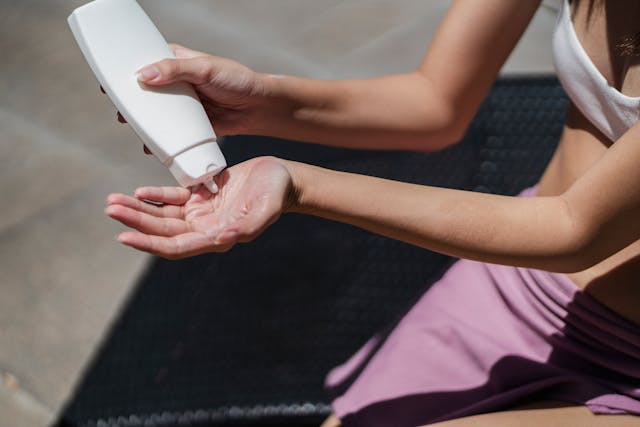
How does sunscreen work? Sunscreen works by either reflecting the ultraviolet rays back up, or by absorbing the ultraviolet rays.
When we go out into direct sunlight, we are coming into a lot of energy that the sun is sending our way. The sun releases energy as electromagnetic waves in a whole range of wavelengths. The radiation with the shortest wavelengths are X-rays. They have a wavelength of 2 nanometers. The electromagnetic waves with the longest wavelengths are radio waves and they have a wavelength of ten meters. The energy in the middle, with wavelengths of between 400 and 700 nanometers are the ones that we can see and they make up the visible light spectrum. It is the ones that we can’t see that burn is on a sunny day. Waves with a shorter frequency have more energy than waves with a longer frequency. Ultraviolet light is the energy band just above visible light and this is what burns us when we are out in the sun. The energy can enter the skin and damage the cells there, causing sunburns. There are three types of UV light and they are divided up by their wavelength. UVA has a wavelength of 315 to 400 nanometers. This is not stopped by the ozone in the. UVB has a wavelength of 280 to 315 nanometers. 95% of it is stopped by the ozone in the atmosphere. And UVC, which has a wavelength of 100 to 280 nanometers. All of UVC is stopped by the ozone layer. A smaller wavelength is a sign of more energy and UVC has far more energy than UVA. Luckily, it is all stopped by the ozone layer. Because of the whole in the ozone layer, there are places where it reaches Earth and that can be dangerous. UVB has more energy than UVA, but a lot more UVA reaches Earth so it is responsible for more sunburns and skin cancers. To prevent this, we use sunscreen.
There are two types of sunscreen. One type reflects the ultraviolet light and the other kind absorb it. Let’s look at the ones that reflect the ultraviolet light first. To reflect the light, the sunscreens needs to have a cream that contains metals, or something that can reflect the light. These metals also need to be small enough that they can comfortably sit in the cream and not be noticeable. Basically, a reflective sunscreen is similar to just wearing a metal sleeve, but a little easier. The most common material in this kind of sunscreen are titanium dioxide or zinc oxide. These metals have a very high reflective index, which makes them perfect. They are ground down into a powder so that they can be mixed into the lotion that you spread on your skin. The particles used to be much bigger and this kind of sunscreen was thick and white, but now they are so small that you can’t see them.
The other kind of sunscreen contains chemicals such as avobenzone and oxybenzone. These particles are suspended in the sunscreen and they absorb ultraviolet light. When they absorb it, they break down into smaller particles, and they release heat in the process. Because this type of sunscreen uses chemicals, they can be absorbed into the body and some people might have an allergic reaction to them, but they are completely safe.
Sunscreens are rated for how much UV light they can protect you from. Each sunscreen has an SPF rating. SPF stands for sun protection factor, and we quite often shorten it to just factor. This is then followed by a number which shows how strong the sunscreen is. There are different numbers but 15, 30, 50, and 100 are common. It sounds like factor 100 is much stronger than factor 15, but it doesn’t quite work like that. The factor number is the amount of UVB rays that the sunscreen will let through. A factor fifteen sunscreen will let through 1/15th of the radiation. That means it blocks 93% of it. Factor 30 lets through 1/30th of the radiation, which means it blocks 97%. And factor 100 lets through 1/100th of the radiation, which means it blocks 99%. There is not a huge difference between all of them.
People have used some kind of sunscreen for as long as there have been people. Animals use substances like mud as sunscreen as well. Modern style sunscreens were invented in 1932 and gradually became popular. It was the Second World War that really brought them to the attention of the public because the US army realized how valuable sunscreen could be to troops stationed in the Pacific. Once the war finished, those troops wanted to buy sunscreen. And this is what I learned today.
Sources
https://www.epa.govt.nz/community-involvement/science-at-work/science-of-sunscreen
https://en.wikipedia.org/wiki/Sunscreen
https://www.bbc.com/news/articles/c1lj5r48vmmo
https://www.health.harvard.edu/staying-healthy/the-science-of-sunscreen
https://www.mdanderson.org/cancerwise/how-does-sunscreen-work.h00-159698334.html
https://spaceplace.nasa.gov/sunburn/en
https://global.canon/en/technology/s_labo/light/002/01.html
https://www.slchemtech.com/news/can-titanium-dioxide-tio2-protect-against-ultraviolet-rays.html
https://www.livescience.com/32666-how-does-sunscreen-work.html
Photo by Armin Rimoldi: https://www.pexels.com/photo/faceless-woman-applying-lotion-on-hand-on-sunny-day-5269653/
